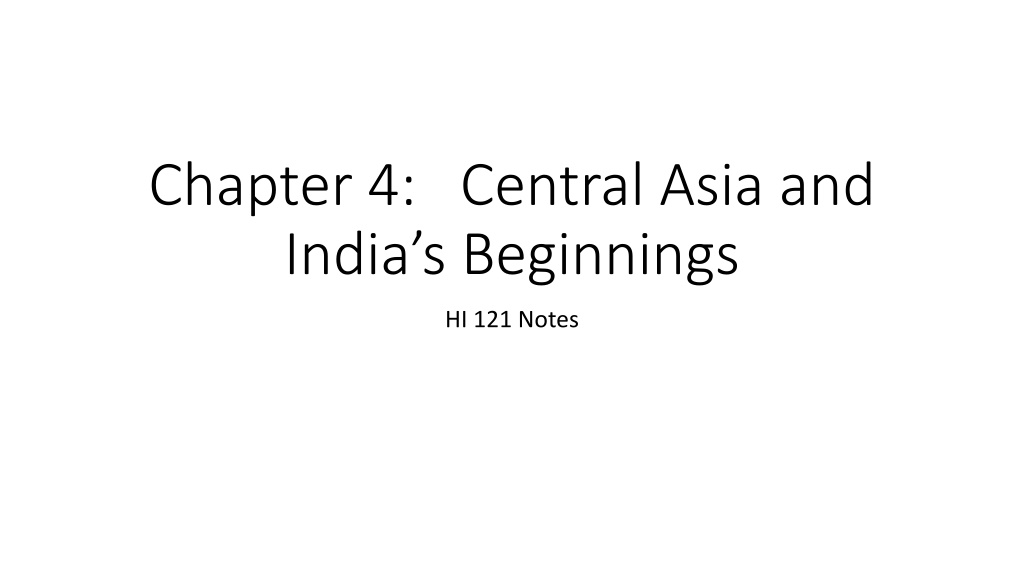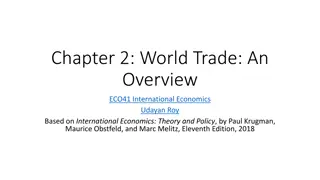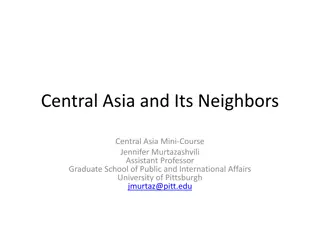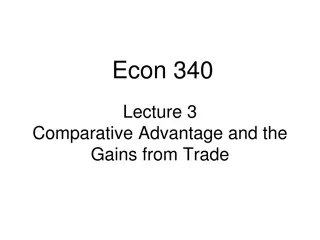Early Civilizations and Trade Networks in Central Asia and India
The chapter explores the Indus Valley Civilization, early trade routes, and urbanized societies like Mohenjo-Daro and Harappa in India. It delves into the significance of Central Asia's steppe lands, the Vedic Epoch, and the cultural developments in the region during ancient times.
Download Presentation

Please find below an Image/Link to download the presentation.
The content on the website is provided AS IS for your information and personal use only. It may not be sold, licensed, or shared on other websites without obtaining consent from the author. Download presentation by click this link. If you encounter any issues during the download, it is possible that the publisher has removed the file from their server.
E N D
Presentation Transcript
Chapter 4: Central Asia and India s Beginnings HI 121 Notes
Indus Valley Civilization and early trade Farming on the flood plains began around 6000 BCE By 4000 BCE the region had a dense population and numerous fortified villages Soil Erosion and frequent, violent flooding constantly plagued settled life along these river banks, so preplanning was essential
Indus Valley Civilization and early trade In India s earliest stages, the trafficking relied chiefly on land routes although there was some waterborne trade within the Gulf and along coastal regions of southern Asia. Gradually, sea routes opened into the Indian Ocean, the Red Sea, and the Persian Gulf. This development placed India at the center of a huge trade network that linked it with the eastern Mediterranean, East Africa, and other parts of Asia.
Mohenjo-Daro and Harappa In early twentieth century, archaeologists found that a highly advanced, urbanized civilization had existed since the middle of the third millennium BCE! There were remnants of large, carefully constructed walls and evidence of standardized structures Each was more than three miles across and probably housed more than 100,000 people. Evidence of theocracy rule This civilization is sometimes called Dravidian
Early Civilization of Central Asia Steppe land = pastoral nomads Domestication of the horse and Bactrian camel revolutionized life Revolutionized warfare with horse-drawn chariots, bridle and bits made mounted warfare possible in comparison to infantry-based armies. Bactria (Gandhara) region Taxila, Balkh, and Peshawar = commercial centers that formed the western end of the Silk Road
Indias Vedic Epoch (1500-500 B.C.E.) Aryans and their Indo-European speaking relatives were among the earliest nomadic, horse breeding people of Ancient Asia. Vedas ancient oral epics written in Sanskrit They were aggressive and set themselves up to be the master group They worshiped gods of the sky and storm They made impressive use of bronze weaponry and horse-drawn chariots in battle Rigveda oldest and most important Veda Raja - chieftain
The Beginnings of the Caste System Brahmins Priests Kshatrija Warriors Vaishya Freemen, farmers, traders Shudra Peasant farmers Pariahs Outcasts Jati subcastes = more than 3,000 castes and 25,000 subcastes today
Brahmanism and the Origins of Hinduism Hinduism - Both more and less than a religion as the West understands that term: it is a way of life, a philosophical system, an inspiration for art, and the basis of all Indian political theory in the past. Religion of majority of Indians Fourth largest in the world
Hinduism Brahmanism early form of Hinduism Three new modes of thought: Jainism made up of high-caste people representing 2% of India s pop. Bhakti Hinduism resisted Buddhism by making traditional Hindu gods more approachable allowing them spiritual fulfillment Buddhism Laws of Manu
Hinduism Basic principles and beliefs: The nonmaterial, unseen world is real and permanent one. The universe works as a Great Wheel, with epochs, events, and lives repeating themselves never ending. The individual dies, but her soul reincarnates (Samara), being born, living, and dying again and again and again as the wheel turns. Karma: Determines the next caste. Justice is rendered as good karma, which results in birth into higher caste in the next life; bad karma, into a lower one. One must strive for good karma through following the code of morals prescribed for one s caste, called dharma as closely as one can. One meaning of dharma is duty; one has a duty to obey the rules of caste.
Daily life and the position of women Descent of women s status with the arrival of the Aryan nomads Law of Manu dictates relationship Sati the ritual of widow s suicide Purdah isolation from all non-family males
Buddhism Began in India as an intellectual and emotional revolt against the emptiness of Verdic ritualism Rejected the idea of immortal life and the gods, it was turned into a supernatural belief system soon after the death of its founder, the Buddha
Siddhartha Gautama An Indian aristocrat Was the Buddha or Enlightened One As a young man, he wandered for several years through the north of India seeking more satisfying answers to the riddle of life Buddhism eventually came to be much more important in China and Japan than in India, where it was practically extinct by 1000 CE After death, followers made him into a god with eternal life
Eightfold Path Spiritual bliss, or nirvana demands right ideas, right thought, right speech, right action, right living, right effort, right consciousness, and right meditation. Assured of conquering desire and will be therefore, released from suffering it these steps are followed Heart of Buddha s message is suffering and loss in this life are caused by the desire for an illusory power and happiness
Buddhas movement also gradually split into two major branches: Theravada, or the narrower vehicle is the stricter version of the faith. It emphasizes the monastic life for both men and women. It claims to be the pure form of the Buddha s teachings and rejects the idea of reincarnation. Mahayana, or the larger vehicle is much more liberal in its beliefs, viewing the doctrines of the Buddha as a sort of initial step rather than as the ultimate word.
The Mauryan Dynasty Founder Chandragupta Maurya: Succeeded in seizing supreme powers in northwestern India upon the withdrawal of the Greeks Ashoka Third and greatest of the Mauryan rulers; the founding spirit of Indian unity and nationhood Spread Buddhist faith in India
Trade and Spread of Buddhism Silk Road Sea Routes























